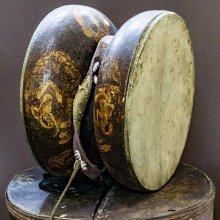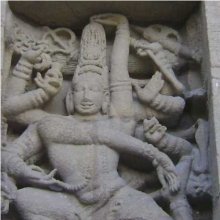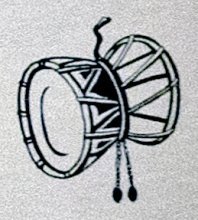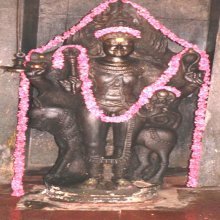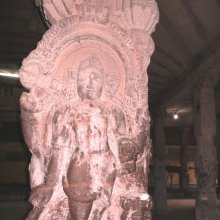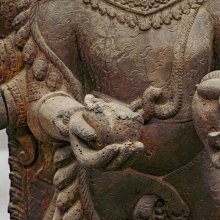Damaru, Ḍamaru: 24 definitions
Introduction:
Damaru means something in Buddhism, Pali, Hinduism, Sanskrit, the history of ancient India, Marathi, Hindi, biology. If you want to know the exact meaning, history, etymology or English translation of this term then check out the descriptions on this page. Add your comment or reference to a book if you want to contribute to this summary article.
Alternative spellings of this word include Damru.
Images (photo gallery)
(+17 more images available)
In Hinduism
Shilpashastra (iconography)
Source: Google Books: Elements of Hindu iconographyḌamaru (डमरु) is a small drum with a hollow body open at both ends. Over each of the open ends of this hollow body is stretched a membrane which is held in position firmly by means of a string passing to and fro over the length of the body of the drum. By pressing these strings, the tension of the membranes may be altered at will so as to produce different notes by striking thereon, or by rubbing one of the membranes with a resined stick. Sometimes there is a string attached to the middle of the body of the drum; and to the end of this string is attached a bead. By holding the drum in the middle and shaking it suitably, this string with the bead may be made to strike against the membranes alternately and produce the required sound.
Source: Red Zambala: Hindu Icons and Symbols | TrinityḌamaru refers to the “hour-glass shaped drum”, held in the right upper hand of Naṭarāja—symbolises the act of creation. According to Tantric teachings the act of creation takes place through sonic vibration. This primary sound is symbolised by the drum, from which all the sounds of the Sanskrit alphabet originated at the beginning of time. The process of creating, cognising and naming are all symbolised by the drum.
The two sides of the drum represent the pairs of opposites and their merging in the centre. God and evil, male and female, day and night etc. are all merely two necessary ends of the same continuum.
Source: Red Zambala: Hindu Icons and Symbols | IntroductionḌamaru (“hour-glass drum”).—Union of the masculine and feminine and the projection of the universe through sound. When the two halves part the sound ceases and the universe dissolves.
Source: Shodhganga: The significance of the mūla-beras (śilpa)1) Ḍamaru (डमरु) refers to a type of musical instrument, representing one of the several “attributes” (āyudha) or “accessories” of a detiy commonly seen depicted in Hindu iconography, defined according to texts dealing with śilpa (arts and crafs), known as śilpaśāstras.—The ḍamaru is an instrument generally found in the hands of the images of Śiva and of his manifestations such as Bhairava. Ḍamaru is a small drum with a hollow body open at both ends. Over each of the open ends of this hollow body is stretched a membrane which is held in position firmly by means of a string passing to and fro over the length of the body of the drum. By pressing these strings, the tension of the membranes may be altered at will so as to produce different notes by striking thereon, or by rubbing one of the membranes with a resined stick. Sometimes there is a string attached to the middle of the body of the [Ḍamaru] drum; and to the end of this string is attached a bead.
By holding the [Ḍamaru] drum in the middle and shaking it suitably, this string with the bead may be made to strike against the membranes alternately and produce the required sound.
2) Ḍamaru (डमरु) or Ḍamaruhasta refers to “holding drum” and represents one of the twenty-four gestures with a single hand, as defined according to texts dealing with śilpa (arts and crafs), known as śilpaśāstras.—Accordingly, pratimā-lakṣaṇa (body postures of the icons) is comprised of hand gestures (hasta, mudrā or kai-amaiti), stances/poses (āsanas) and inflexions of the body (bhaṅgas). There are thirty-two types of hands [viz., ḍamaru-hasta] classified into two major groups known as tolirkai (functional and expressive gestures) and elirkai (graceful posture of the hand).

Shilpashastra (शिल्पशास्त्र, śilpaśāstra) represents the ancient Indian science (shastra) of creative arts (shilpa) such as sculpture, iconography and painting. Closely related to Vastushastra (architecture), they often share the same literature.
Kavya (poetry)
Source: archive.org: Naisadhacarita of SriharsaḌamaru (डमरु) refers to “a kind of drum generally used by the Kāpālikas”.—Cf. Lasaḍḍimba (“top”) which is mentioned in the Naiṣadha-carita 22.53.

Kavya (काव्य, kavya) refers to Sanskrit poetry, a popular ancient Indian tradition of literature. There have been many Sanskrit poets over the ages, hailing from ancient India and beyond. This topic includes mahakavya, or ‘epic poetry’ and natya, or ‘dramatic poetry’.
Shaktism (Shakta philosophy)
Source: Google Books: ManthanabhairavatantramḌamaru (डमरु) refers to a “double-headed drum”, according to the Brahmayāmala verse 21.72-73ab.—The renouncer in Vedic times wore ochre coloured clothes. This practice continues amongst Śaiva renouncers who attribute the origin of their orders to Śaṅkarācārya. Vaiṣṇava renouncers, who in their outer appearance resemble in many respects their Śaiva counterparts, generally wear white. Modern Śākta renouncers wear red clothes. A similar practice is recorded in the Brahmayāmala, a text that may well belong to the seventh or eighth century. In one of a series of vows (vrata) described there, the initiate may chose to perform he should wear “black and red clothes and no upper garment”. Another prescribes that: “wearing red clothes, a red garland and (smeared with) unguent, he has red ornaments and holds an ascetic’s staff. In particular, he should always carry a skull and a double-headed drum [i.e., ḍamaru]”.

Shakta (शाक्त, śākta) or Shaktism (śāktism) represents a tradition of Hinduism where the Goddess (Devi) is revered and worshipped. Shakta literature includes a range of scriptures, including various Agamas and Tantras, although its roots may be traced back to the Vedas.
Shaivism (Shaiva philosophy)
Source: Google Books: Manthanabhairavatantram (shaivism)Ḍamaru (डमरु) (Cf. Ḍamaruka) refers to a “double-headed drum” and represents one of the attributes of Svacchanda, according to the Śrīmatottara-tantra, an expansion of the Kubjikāmatatantra: the earliest popular and most authoritative Tantra of the Kubjikā cult. Accordingly, “O goddess, Svacchanda is in the middle, within the abode of the triangle. Very powerful, he has five faces with three times five flaming eyes. [...] O fair lady, my attributes—trident, dagger, sword, the king of the snakes, and rosary—adorn the right (arms). O beloved, a skull, double-headed drum [i.e., ḍamaru], javelin, noose and goad—(these) are my divine, brilliant and very auspicious weapons that (are held) in the left (hands). The king of snakes (hangs) on the shoulder and a garland of skulls hangs (from the neck). There is a necklace of scorpions around the throat and the ears are adorned with snakes. [...]”.

Shaiva (शैव, śaiva) or Shaivism (śaivism) represents a tradition of Hinduism worshiping Shiva as the supreme being. Closely related to Shaktism, Shaiva literature includes a range of scriptures, including Tantras, while the root of this tradition may be traced back to the ancient Vedas.
Purana and Itihasa (epic history)
Source: archive.org: Shiva Purana - English TranslationḌamaru (डमरु) is the name of a type of drum, according to the Śivapurāṇa 2.3.27 (“Description of the fraudulent words of the Brahmacārin”).—Accordingly, as Śiva (in guise of a Brahmacārin) said to Pārvatī: “[...] Sandal paste is applied on your body, while the ashes of the funeral pyre on that of Śiva. Where your silken garment and where the elephant-hide of Śiva. Where the divine ornaments and where the serpents of Śiva? Where the deities that move about and where Śiva, fond of goblins and their oblations? Where the pleasing sound of his tabor? Where His peculiar drum called Damaru [i.e., ḍamaru]? Where the set of fine drums and the inauspicious sound of his horn? [...]”.

The Purana (पुराण, purāṇas) refers to Sanskrit literature preserving ancient India’s vast cultural history, including historical legends, religious ceremonies, various arts and sciences. The eighteen mahapuranas total over 400,000 shlokas (metrical couplets) and date to at least several centuries BCE.
Yoga (school of philosophy)
Source: ORA: Amanaska (king of all yogas): A Critical Edition and Annotated Translation by Jason BirchḌamaru (डमरु) or “drum” refers to one of the accoutrements carried by the Sādhaka, according to the Kubjikāmata verse 25.130.—Accordingly: For one who has remembered [the sound of] the ḍamaru [drum] in the no-mind [state], which is free of ills, Kuṇḍalinī, in the form of Māyā, remains situated in the navel”.

Yoga is originally considered a branch of Hindu philosophy (astika), but both ancient and modern Yoga combine the physical, mental and spiritual. Yoga teaches various physical techniques also known as āsanas (postures), used for various purposes (eg., meditation, contemplation, relaxation).
In Buddhism
Tibetan Buddhism (Vajrayana or tantric Buddhism)
Source: academia.edu: The Structure and Meanings of the Heruka MaṇḍalaḌamaru (डमरु) refers to a “small drum” and represents one of the items held in the right hand of Heruka: one of the main deities of the Herukamaṇḍala described in the 10th century Ḍākārṇava chapter 15. Heruka is positioned in the Lotus (padma) at the center; He is the origin of all heroes; He has 17 faces (with three eyes on each) and 76 arms [holding, for example, ḍamaru]; He is half black and half green in color; He is dancing on a flaming sun placed on Bhairava and Kālarātrī.
Source: OSU Press: Cakrasamvara SamadhiḌamaru (डमरु) refers to a “double-headed drum” which is used to describe Cakrasaṃvara, according to the Saṃvaramaṇḍala of Abhayākaragupta’s Niṣpannayogāvalī, p. 45 and n. 145; (Cf. Cakrasaṃvaratantra, Gray, David B., 2007).—Accordingly, [while describing the iconography of Cakrasaṃvara]: “In the Saṃvara Maṇḍala atop Mount Sumera within a vajra-canopy there is a variegated lotus, on top of that a palace, in the middle of which is the Blessed Lord, standing in ālīḍhāsana, "archer's pose", [...] possessing a vyāghracarma, "tiger skin" and twelve arms, the foremost arms holding a vajra and ghaṇṭā, embracing Vajravārāhī, the uppermost arms holding a gajacarman, "elephant skin", dripping with blood, the remaining arms holding, starting second from the top, on the right, a ḍamaru, "double-headed drum", paraśu, "ax", kartika, "flaying knife", triśūla, "trident", on the left, a khaṭvāṅga, "staff", kapāla, "skull bowl", pāśa, "noose", and brahmamuṇḍa, "lopped head of Brahma", [...]”.
Note: The ḍamaru, "double-headed drum", invokes all the Buddhas and symbolizes the inner fire (caṇḍalī-yoga).
Source: MDPI Books: The Ocean of HeroesḌamaru (डमरु) refers to a “drum” (i.e., one of the attributes held in the hands of a deity), according to the 10th-century Ḍākārṇava-tantra: one of the last Tibetan Tantric scriptures belonging to the Buddhist Saṃvara tradition consisting of 51 chapters.—Accordingly, “[...] [He (The Causal Vajra-holder)] stands in the ālīḍha posture with the feet placed on both Hara and Gaurī [He holds] (1) a vajra and (2) a bell, (3)(4) an elephant’s skin, (5) a drum (ḍamaru), (6) a knife, (7) an axe, (8) a trident, (9) a skull staff, (10) a pot, (11) a noose, and (12) a hairless head in the left and right [hands]. [...]”.

Tibetan Buddhism includes schools such as Nyingma, Kadampa, Kagyu and Gelug. Their primary canon of literature is divided in two broad categories: The Kangyur, which consists of Buddha’s words, and the Tengyur, which includes commentaries from various sources. Esotericism and tantra techniques (vajrayāna) are collected indepently.
India history and geography
Source: Mandala Texts: Parzo: Wood CarvingDamaru (ཌ་མ་རུ་) refers to certain traditional Bhutanese religious instruments, made in wood-carving (patra).—Bhutan has a vibrant culture of patra (པ་ཏྲ་) or wood carving. The patra carving is seen the production of books, images, artchitectual designs, furniture and many other wooden artefacts. [...] Bhutanese carvers also carve designs and motifs on furniture. Traditional tables known as chogdrom (ཅོག་སྒྲོམ་) have carved decorative designs on three sides. High thrones and seats are also adorned with intricate carvings. The altar piece, which is kept in the family shrine in the shape and design of a miniature temple and called choesham (མཆོག་གཤམ་), is often made with many detailed and intricate carvings. Religious instruments such as stupas, phurpa (ཕུར་པ་) dagger and damaru (ཌ་མ་རུ་) handheld drums are also carved from wood. Musical instruments such as large drums and dramnyen (སྒྲ་སྙན་) lute are also carved out of wood.

The history of India traces the identification of countries, villages, towns and other regions of India, as well as mythology, zoology, royal dynasties, rulers, tribes, local festivities and traditions and regional languages. Ancient India enjoyed religious freedom and encourages the path of Dharma, a concept common to Buddhism, Hinduism, and Jainism.
Biology (plants and animals)
Source: Wisdom Library: Local Names of Plants and DrugsDamaru [डमरू] in the Nepali language is the name of a plant identified with Maclura cochinchinensis (Lour.) Corner from the Moraceae (Mulberry) family having the following synonyms: Vanieria cochinchinensis, Cudrania javanensis, Cudrania cochinchinensis. For the possible medicinal usage of damaru, you can check this page for potential sources and references, although be aware that any some or none of the side-effects may not be mentioned here, wether they be harmful or beneficial to health.

This sections includes definitions from the five kingdoms of living things: Animals, Plants, Fungi, Protists and Monera. It will include both the official binomial nomenclature (scientific names usually in Latin) as well as regional spellings and variants.
Languages of India and abroad
Marathi-English dictionary
Source: DDSA: The Molesworth Marathi and English Dictionaryḍamaru (डमरु).—m (S) A sort of tabor shaped like an hourglass. 2 A little rattle, a windlass &c. of this shape.
Source: DDSA: The Aryabhusan school dictionary, Marathi-Englishḍamaru (डमरु).—m A sort of tabor shaped like an hour–glass. A little rattle.
Marathi is an Indo-European language having over 70 million native speakers people in (predominantly) Maharashtra India. Marathi, like many other Indo-Aryan languages, evolved from early forms of Prakrit, which itself is a subset of Sanskrit, one of the most ancient languages of the world.
Sanskrit dictionary
Source: DDSA: The practical Sanskrit-English dictionaryḌamaru (डमरु).—A sort of small drum shaped like an hourglass and generally used by Kāpālikas; (sometime regarded as n. also); चण्डैर्डमरुनिर्घोषैर्घर्घरं श्रुतवान् ध्वनिम् (caṇḍairḍamarunirghoṣairghargharaṃ śrutavān dhvanim) Rāj. T.2.99.
Derivable forms: ḍamaruḥ (डमरुः).
Source: Cologne Digital Sanskrit Dictionaries: Shabda-Sagara Sanskrit-English DictionaryḌamaru (डमरु).—m.
(-ruḥ) 1. A musical instrument, a sort of small drum, shaped like an hour-glass, and held in one hand usually carried by Kapalikas. 2. Any thing surprising, any strange occurence, &c. E. ḍama imitative sound, ṛ to go or get uṇ affix and the vowel changed.
Source: Cologne Digital Sanskrit Dictionaries: Monier-Williams Sanskrit-English Dictionary1) Ḍamaru (डमरु):—[from ḍamara] m. ([cf. Lexicographers, esp. such as amarasiṃha, halāyudha, hemacandra, etc.]) a sacred drum, shaped like an hourglass, used by the god Śiva and by Buddhist mendicant monks for a musical accompaniment in chanting, cf. [Monier-Williams’ Buddhism ]384, 385 [Rājataraṅgiṇī ii, 99; Prabodha-candrodaya iii, 14]
2) [v.s. ...] surprise, [cf. Lexicographers, esp. such as amarasiṃha, halāyudha, hemacandra, etc.]
Source: Cologne Digital Sanskrit Dictionaries: Yates Sanskrit-English DictionaryḌamaru (डमरु):—(ruḥ) 2. m. Musical instrument, small drum; strange event.
[Sanskrit to German]
Sanskrit, also spelled संस्कृतम् (saṃskṛtam), is an ancient language of India commonly seen as the grandmother of the Indo-European language family (even English!). Closely allied with Prakrit and Pali, Sanskrit is more exhaustive in both grammar and terms and has the most extensive collection of literature in the world, greatly surpassing its sister-languages Greek and Latin.
Hindi dictionary
Source: DDSA: A practical Hindi-English dictionaryḌamarū (डमरू) [Also spelled damru]:—(nm) a leather-covered musical percussion instrument, narrow in the middle and wider at the ends; ~[madhya] a narrow strip of land or water connecting two expanses of water or two tracts of land respectively.
...
Kannada-English dictionary
Source: Alar: Kannada-English corpusḌamaru (ಡಮರು):—[noun] = ಡಮರ [damara].
--- OR ---
Ḍāmaru (ಡಾಮರು):—[noun] = ಡಾಂಬರು [dambaru].
Kannada is a Dravidian language (as opposed to the Indo-European language family) mainly spoken in the southwestern region of India.
See also (Relevant definitions)
Starts with: Damaru Hasta, Damarua, Damarudhara, Damarudra, Damaruga, Damaruhasta, Damaruka, Damarukadhara, Damarukagarbhagaramahatmya, Damarukakara, Damarukara, Damarunirghosha, Damaruvallabha, Damaruvata, Damaruyamtra, Damaruyantra, Tamaru, Tamaruci.
Ends with: Apatamaru, Bili-damaru, Doopadamaru, Dupa-damaru, Dupadamaru, Jaladamaru, Pantamaru, Tamaru, Tella-damaru, Telladamaru.
Full-text (+168): Damarin, Damaruyantra, Sutrakona, Sutrakonaka, Damaruka, Tella-damaru, Dupa-damaru, Tamaru, Damaru Hasta, Sayudha, Dugadugi, Damarava, Bili-damaru, Gangaladhar, Damururekhe, Ekasutra, Damarunirghosha, Dugdugi, Nirghosha, Damru.
Relevant text
Search found 37 books and stories containing Damaru, Ḍamaru, Ḍamarū, Ḍāmaru; (plurals include: Damarus, Ḍamarus, Ḍamarūs, Ḍāmarus). You can also click to the full overview containing English textual excerpts. Below are direct links for the most relevant articles:
Amarakoshodghatana of Kshirasvamin (study) (by A. Yamuna Devi)
Musical instruments (e.g., Stringed, Percussions, Cymbals and Wind-blown) < [Chapter 4 - Cultural Aspects]
Varahi Tantra (English Study) (by Roberta Pamio)
Chapter 29 - The worship of Caṇḍikā < [Summary of the Vārāhī Tantra]
Chapter 22 - The the Six Āmnāyas < [Summary of the Vārāhī Tantra]
Chapter 24 - Kālīkrama (according to the seventh chapter of the Parātantra) < [Summary of the Vārāhī Tantra]
Chaitanya Bhagavata (by Bhumipati Dāsa)
Verse 2.8.100 < [Chapter 8 - The Manifestation of Opulences]
Pallava period (Social and Cultural History) (by S. Krishnamurthy)
Percussion instruments (Anaddha) < [Chapter 4 - Material Culture of the People]
Musical Instruments (Introduction) < [Chapter 4 - Material Culture of the People]
Coiffure of Men < [Chapter 4 - Material Culture of the People]
Puranic encyclopaedia (by Vettam Mani)
Rudra-Shiva concept (Study) (by Maumita Bhattacharjee)
3. Weapons of Śiva < [Chapter 5 - Rudra-Śiva in the Purāṇic Literature]
37. Sunartakanaṭa incarnation < [Chapter 5 - Rudra-Śiva in the Purāṇic Literature]
Related products
